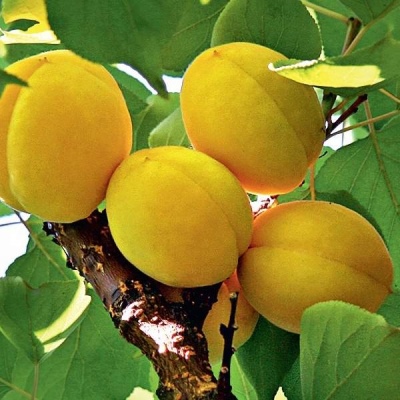
- Name synonyms: Prunus armenica Uspekh
- Tree height, m: 3
- Fruit weight, g: 25
- Fruit shape: rounded
- Skin : thin
- Fruit color: light orange, on the sunny side - with reddish dots
- Pulp color : amber yellow
- Pulp (consistency): juicy, delicate, has minor fibers, dense
- Fruit taste: sweet, with a little acid
- Appointment: for fresh consumption, for all types of processing
The apricot variety Success is also called Prunus armenica Uspekh. It is intended to be eaten raw, and it can also be suitable for almost all types of processing.
Description of the variety
This type of apricot is medium-sized. The height of the tree is 3 meters on average. The crown on it is dense, wide-pyramidal, rather strong and weakly branching. It has a smooth surface and brown color with a slight reddish tint.
Skeletal branches on plants grow strong. On trees, ovoid leaf plates grow. Their tips are pointed, the edges are serrated, the petioles are short and colored.
Flowers on trees are pink-white. The size is average. Variety Success is partially self-fertile. It should be planted next to other types of apricots.
Fruit characteristics
Ripe fruits are of medium size. The weight of one fruit averages 25 grams. The shape is round.
The color of ripe apricots is light orange. Fruits that grow on the sunny side have an orange surface with reddish dots.
The skin on the fruit is rather thin. The pulp has an amber yellow color. It is very juicy, tender and dense.
Taste qualities
Apricots of this type have a sweet taste with a slight sourness. According to experts, the taste of ripe fruits deserves a tasting score of 4-4.5 points. They can be used as a fresh dessert, and they are also perfect for preparing various sweet dishes.
Ripening and fruiting
Apricots Success begin to bear fruit 5-6 years after planting. Their ripening dates are late. Flowering dates are at the end of April-May. Fruiting occurs in late August - early September.

Yield
The variety has an average yield. From one healthy tree, it will be possible to harvest an average of 30-35 kilograms of fruit.
Growing and care
Young seedlings of this variety are best planted in sandy loam, medium loamy places with well-permeable soil. The best option for them would be the sunny side, but you can plant vegetation in partial shade.
Plants will need moderate watering as they grow. Remember that this variety is partially self-fertile, so it should be planted next to other varieties of apricots (Triumph, Pineapple).
Apricots Success has good frost resistance. They are able to withstand temperatures as low as -39.9 degrees under the snow. In addition, the species is also resistant to prolonged droughts.



Disease and pest resistance
Apricots Success is quite resistant to diseases and pests. But at the same time, the culture sometimes still undergoes moniliosis. It most often develops due to damp and cool weather. In case of damage on trees, shoots will gradually begin to fade. To cure the plants, all damaged parts are removed from it, then it will be necessary to process it with copper sulfate or Bordeaux liquid.
And also the culture can be affected by fruit rot. In this case, the fungal infection affects the fruit. They start to rot. In spring, the disease spreads to young ovaries.
To cure diseased plantings, you can use the drug "Fitosporin-M", you can also use a solution with iodine for this (10 ml of iodine should fall on 10 liters of water). Moreover, the processing should be performed several times at short intervals.
Sometimes on apricots of this variety you can see aphids, leaf rollers and moths. To get rid of these pests, you can apply chemical insecticides ("Fufanon", "Fitoverm", "Inta-Vira").

Review overview
Many gardeners have left good reviews about this type of apricot. Separately, it was noted that ripe fruits have excellent taste characteristics. The variety will allow you to get a full harvest every year. In addition, some gardeners noted that vegetation is rarely exposed to diseases and pests.































































